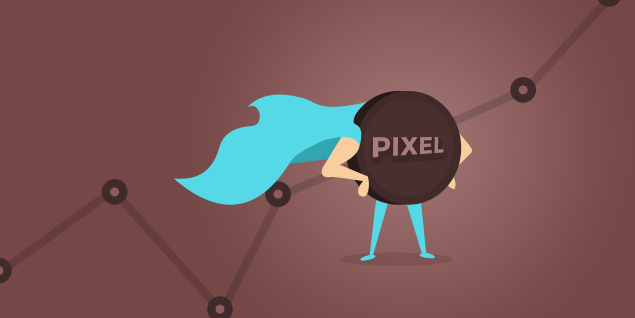The Tiny Line Of Code That Will Rescue Your Dealership’s Facebook ROI
Pixels aren’t just for your TV, computer, and phone screens anymore. Facebook offers a very small, but very important line of code called a pixel tag to help measure ad effectiveness, and bucket your dealership’s website visitors. Is your pixel running correctly? Does your dealership even have one installed?

Even if your dealership isn’t running targeted ads to convert more shoppers on Facebook, you can still benefit from installing the Facebook pixel.
Once the code is installed properly, you will begin bucketing every individual who visits your dealership’s website.
If you ever decide to run Facebook ads, you can then reach these shoppers immediately with very specific and targeted vehicle ads designed to drive them back to your site.
The “NEW” Pixel
Not familiar with the Facebook pixel? Don’t worry; many businesses aren’t up to speed on the real power this little code holds.
But trust us, you want—no, you NEED—one.
According to Facebook, the pixel gives you the power to report and optimize for conversions, build audiences, and get insights about how people use your dealership’s website. Pretty cool stuff, because it virtually guarantees a better handle on your Facebook ROI.
Last year, Facebook rolled its Custom Audience retargeting pixel into its conversion pixel, making the tracking process much simpler with a single line of code.
![]()
Our Facebook Team put together this step-by-step guide to get you up, running, and finally tracking (and bucketing) your website visitors. Keep reading to find out if your current pixel is set up properly, or how to install it from scratch!
First, Check If You Have The Right Pixel Running.
To see if your dealership has the right pixel in place, you must first install the Facebook Pixel Helper in your Chrome browser.
Once you’ve added the extension, you will need to pull up your dealership’s website and click on the ![]() icon in the top right hand corner. After clicking, the helper will tell you what your pixel is firing off. There are 3 different scenarios you might see: one (or more) pixels are found, no pixels found, or there’s an error with the pixel that was found.
icon in the top right hand corner. After clicking, the helper will tell you what your pixel is firing off. There are 3 different scenarios you might see: one (or more) pixels are found, no pixels found, or there’s an error with the pixel that was found.
If you run into an error message, Facebook has developed a troubleshooting guide for the most common errors. Here’s a quick look:
Pixel did not load: Your site has a pixel installed, but it is not firing off correctly. This could have to do with an error in the code, or it could be that the pixel was designed to fire off on a dynamic event, such as a button click.
Pixel activated multiple times: A pixel with the same ID and event name was sent multiple times to Facebook. This is typically caught and only counted for as one conversion.
Pixel took too long to load: If the pixel is placed in the wrong section of your web page, it can take too long to load and the conversion may not be tracked correctly.
Pixel is not the only conversion: This happens when multiple conversion events take place, and results in inefficient optimization and tracking. Conversion pixels should be re-used across multiple ads and campaigns, so a single conversion pixel is recommended. If a secondary conversion event occurs based on a person’s interaction with the web page (such as a button click), you can ignore this warning.
No Pixel? No Problem. How To Install The New Facebook Pixel:
Step 1: Create a pixel.
If you have access to your Facebook Business Account, head into the Ads Manager, ads create tool or Power Editor (using a Chrome browser).
From the Ads Manager:
- Click Tools from the top menu.
- Click Create a Pixel.
- Add a name for your pixel. Note: You can only have one name per ad account, so choose one that represents your dealership.
- Click View Pixel Code and then copy the code that’s displayed.
![]()
Step 2: Add the pixel to your dealership’s website.
Once you’ve created your dealership’s unique pixel, it’s time to add it to your site. Your website provider needs to place this one snippet of code between the <head> </head> on all webpages that you want to track conversions on.
![]()
Step 3: Start measuring ROI!
Now that the pixel is installed properly, you’re ready to start running ads and watch the conversions roll in! You’ll be able to see the status of your pixel once your first conversion event is logged (until then, it will appear “unverified.”)
To see the results, log into your Ads Manager. Once there, you’ll be able to monitor each live ad and its conversions.
To locate your Custom Conversions page go to the top, right hand side of your Ads Manager and type “Custom Conversions” in the search bar.
You will be taken to a new page, where you will find conversions for every ad your dealership has run. Click on any ad under Name to see how many conversions that ad generated.
![]()
Facebook is an incredibly powerful ad platform, and its pixel must be in your dealership’s toolkit to track and optimize your ad success. Don’t let another day go by that you aren’t capturing valuable website traffic.
Want more help with the Facebook pixel, or have other Facebook-related questions? Our team is happy to help! Contact us at 941-366-6760 or click here.

